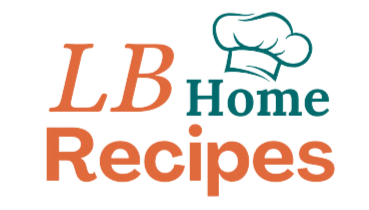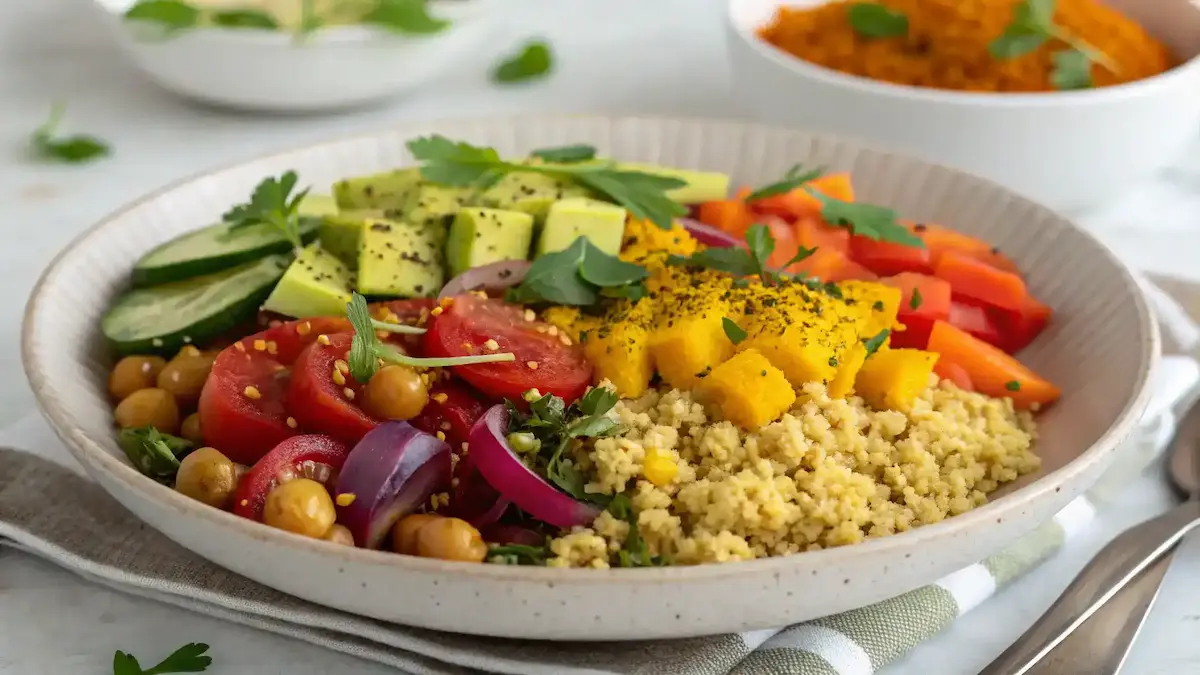Welcome to the vibrant world of vegan gluten free recipes! If you’re looking to enhance your meals while embracing a healthier lifestyle, you’ve come to the right place. Not only are these dishes packed with nutrient-rich ingredients, but they also cater to those with gluten sensitivities. By incorporating whole foods like legumes, grains, and fresh vegetables, you can create delicious meals that are both satisfying and allergy-friendly. Moreover, cooking vegan gluten free recipes allows you to explore a plant-based diet that supports weight management and digestive health. So, whether you’re a seasoned chef or a curious beginner, let’s dive into the art of cooking these delightful dishes together!
Table of Contents
Table of Contents
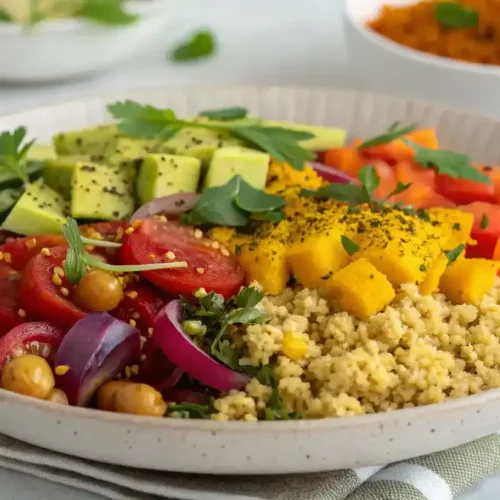
vegan gluten free recipes
Equipment
- 1 Pot For boiling grains and legumes.
- 1 Pan For sautéing vegetables.
- 1 Oven For baking if needed.
Ingredients
Whole Grains
- 1 cup Quinoa Rinse before cooking.
- 1 cup Brown Rice Can be substituted with millet.
Legumes
- 1 can Chickpeas Drained and rinsed.
- 1 cup Lentils Any variety works.
Gluten-Free Flours
- 1 cup Almond Flour Great for baking.
- 1 cup Coconut Flour Use in moderation due to absorbency.
Nuts and Seeds
- 1/2 cup Almonds Chopped or slivered.
- 1/4 cup Chia Seeds For added nutrition.
Dairy-Free Alternatives
- 1 cup Coconut Milk Full-fat for creaminess.
- 1 cup Almond Milk Unsweetened preferred.
Flavor Enhancers
- 2 tablespoons Nutritional Yeast For a cheesy flavor.
- 1 teaspoon Garlic Powder Adjust to taste.
Instructions
Preparation
- Gather all your ingredients and prep your vegetables by chopping and slicing them as needed.
Cooking
- Cook your grains and legumes according to package instructions. Sauté your vegetables in a pan with a bit of olive oil, then combine everything in a large bowl.
Flavoring
- Layer in your spices and herbs, adjusting to taste. Serve warm or store for later.
Notes
| Calories | Fat | Protein | Carbs |
|---|---|---|---|
| 350 | 10g | 15g | 50g |
Key Benefits
When it comes to cooking, embracing vegan gluten free recipes can be a game changer for your health and lifestyle. Not only do these recipes cater to those with gluten sensitivities, but they also offer a treasure trove of benefits that can enhance your overall well-being. Here’s why you might want to dive into the world of vegan gluten free cooking:
- Health Benefits: Vegan gluten free recipes are packed with nutrient-rich ingredients. By focusing on whole foods like legumes, grains, and vegetables, you’re fueling your body with vitamins and minerals that promote better health.
- Allergy-Friendly: These recipes are perfect for those with gluten intolerance or other dietary restrictions. You can enjoy delicious meals without the worry of allergens.
- Weight Management: A plant-based diet can support weight management. By incorporating more fruits and vegetables, you’re likely to consume fewer calories while still feeling satisfied.
- Digestive Health: Many vegan gluten free recipes are high in fiber, which is essential for good digestive health. This can lead to improved gut function and overall wellness.
- Sustainable Eating: Choosing plant-based ingredients is not only good for your health but also for the planet. Vegan gluten free recipes often emphasize sustainable practices, making them a responsible choice.
In summary, vegan gluten free recipes offer a delicious way to nourish your body while being mindful of your health and the environment. So, why not give them a try? You might just find your new favorite dish!
Ingredients
Welcome to the vibrant world of vegan gluten-free recipes! Here, we celebrate the beauty of whole, unprocessed ingredients that not only nourish our bodies but also tantalize our taste buds. Below is a curated list of essential ingredients that will elevate your culinary creations.
- Whole Grains: Quinoa, brown rice, and millet are fantastic gluten-free options. They provide a hearty base for your dishes while being rich in fiber and protein.
- Legumes: Chickpeas, lentils, and black beans are not only protein-packed but also versatile. Use them in salads, stews, or even as a base for veggie burgers.
- Gluten-Free Flours: Almond flour, coconut flour, and chickpea flour are excellent substitutes for traditional wheat flour. They add unique flavors and textures to your baked goods.
- Nuts and Seeds: Almonds, walnuts, chia seeds, and flaxseeds are nutrient-dense and can enhance both flavor and crunch in your recipes. They are perfect for snacking or as toppings.
- Dairy-Free Alternatives: Coconut milk, almond milk, and cashew cream are wonderful substitutes for dairy. They add creaminess to soups, sauces, and desserts.
- Flavor Enhancers: Nutritional yeast, garlic powder, and fresh herbs like basil and cilantro can elevate your dishes. They bring depth and richness to your meals.
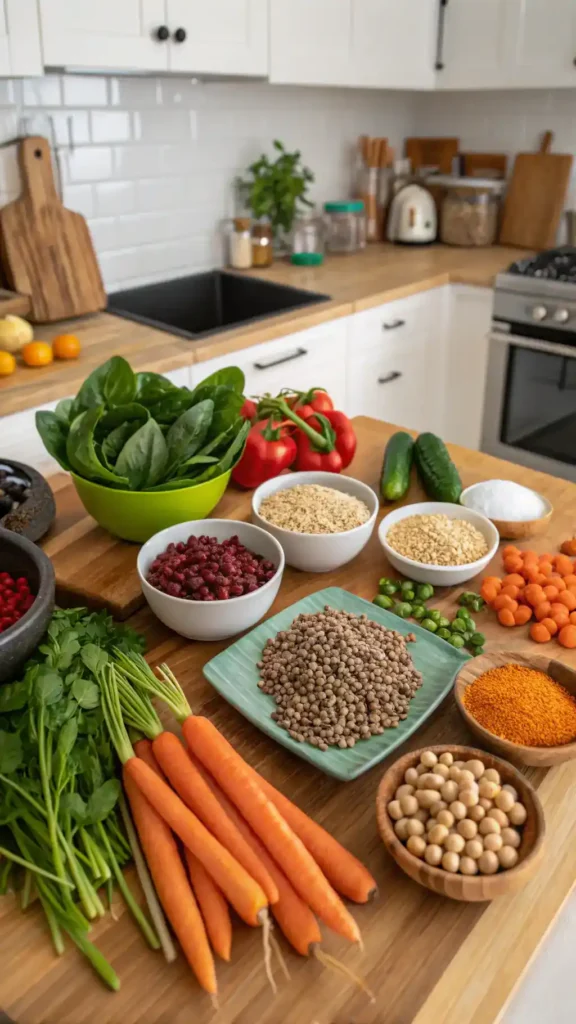
When crafting your vegan gluten-free recipes, remember to choose organic and non-GMO ingredients whenever possible. This not only supports your health but also aligns with a sustainable eating philosophy. Additionally, always check labels to ensure your ingredients are certified gluten-free, especially when it comes to processed items.
By embracing these wholesome ingredients, you’re not just cooking; you’re creating delicious meals that are kind to your body and the planet. So, gather your ingredients and let’s embark on this culinary adventure together!
How to Make Vegan Gluten Free Recipes
Creating delicious vegan gluten free recipes can be both fun and rewarding. Follow these simple steps to whip up meals that are not only healthy but also packed with flavor. Here’s how to get started:
- Gather Your Ingredients: Start by collecting all your ingredients. For vegan gluten free recipes, you’ll need whole foods like quinoa, chickpeas, and gluten-free flours such as almond or coconut flour. This ensures you have everything on hand, saving you time later.
- Prep Your Vegetables: Chop, dice, or slice your vegetables ahead of time. This step is crucial because it allows for quicker cooking. For instance, you can prepare bell peppers, onions, and garlic in advance. Additionally, consider using pre-washed greens to save even more time.
- Choose Your Cooking Technique: Decide on the cooking method that suits your recipe. Whether you’re sautéing, baking, or steaming, each technique brings out different flavors. For example, sautéing vegetables in a bit of olive oil enhances their taste while keeping them nutrient-rich.
- Flavor Layering: As you cook, layer flavors by adding spices and herbs gradually. Start with basics like salt and pepper, then introduce garlic powder or cumin. This method not only enhances the taste but also makes your vegan gluten free recipes more exciting.
- Batch Cooking: If you’re short on time during the week, consider batch cooking. Prepare larger portions of your vegan gluten free meals and store them in airtight containers. This way, you’ll have quick, healthy options ready to go.
- Check for Texture: When making vegan gluten free recipes, achieving the right texture is key. If you’re baking, ensure your batter is not too dry. You can add a bit of dairy-free milk or applesauce to achieve the desired consistency.
- Final Touches: Before serving, taste your dish and adjust the seasoning if needed. Sometimes, a squeeze of lemon or a sprinkle of nutritional yeast can elevate the flavors significantly. This step is essential for ensuring your meal is both delicious and satisfying.
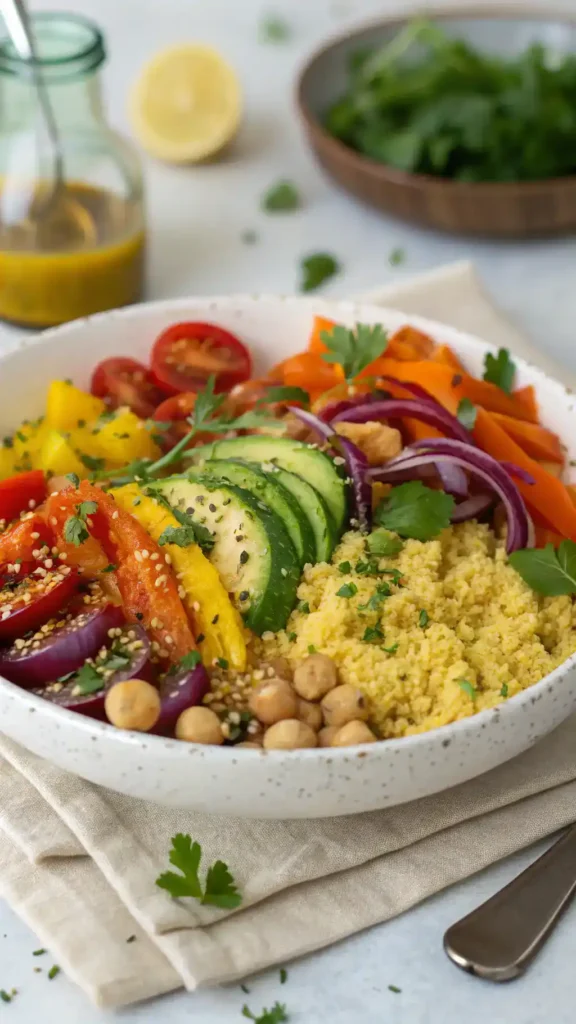
By following these steps, you’ll be well on your way to mastering vegan gluten free recipes. Remember, cooking should be enjoyable, so don’t hesitate to experiment with different ingredients and techniques. Happy cooking!
Pro Tips, Variations & Common Problems
Cooking vegan gluten-free recipes can be a delightful adventure, yet it may come with its own set of challenges. Here are some pro tips and variations to help you navigate this culinary journey with ease.
Expert Tips
1. Texture Matters: To achieve the perfect texture in your vegan gluten-free recipes, consider using a blend of gluten-free flours. For example, mixing almond flour with coconut flour can create a moist and fluffy result. Additionally, adding a tablespoon of ground flaxseed or chia seeds can act as a binder, enhancing the structure of your dish.
2. Flavor Boosters: Don’t underestimate the power of seasoning! Nutritional yeast adds a cheesy flavor to dishes, while smoked paprika can lend a delightful depth. Furthermore, fresh herbs like basil or cilantro can elevate your meals, making them vibrant and aromatic.
3. Ingredient Swaps: If you’re out of a specific ingredient, don’t fret! For instance, if you don’t have chickpeas, white beans or lentils can be excellent substitutes in soups or salads. Moreover, if you’re looking for a dairy-free alternative, try using cashew cream instead of coconut milk for a rich and creamy texture.
Creative Variations
1. Seasonal Ingredients: Embrace the seasons by incorporating fresh, local produce into your vegan gluten-free recipes. For example, in the summer, add zucchini or bell peppers, while in the fall, consider using pumpkin or sweet potatoes for a comforting twist.
2. Global Flavors: Explore international cuisines by infusing your dishes with spices from around the world. For instance, add curry powder for an Indian flair or cumin and coriander for a Middle Eastern touch. This not only enhances flavor but also keeps your meals exciting.
Troubleshooting Common Problems
1. Dry or Crumbly Texture: If your vegan gluten-free recipe turns out dry, it may be due to too much flour or not enough moisture. To remedy this, add a splash of vegetable broth or a bit more plant-based milk. Additionally, consider incorporating applesauce or mashed bananas for added moisture.
2. Lack of Flavor: If your dish tastes bland, try adjusting the seasoning. A pinch of salt can make a significant difference. Also, consider adding a splash of lemon juice or vinegar to brighten the flavors. Remember, tasting as you go is key!
3. Binding Issues: If your mixture isn’t holding together, it’s likely you need a better binder. Ground flaxseed or chia seeds mixed with water can help. Alternatively, try adding a bit of mashed avocado or nut butter, which can also enhance the flavor.
By keeping these tips and variations in mind, you’ll be well-equipped to tackle any challenges that arise while preparing your vegan gluten-free recipes. Enjoy the process, and remember that cooking is all about experimenting and having fun!
Serving Suggestions
When it comes to serving vegan gluten free recipes, presentation is key. Traditionally, these dishes are often enjoyed in communal settings, where sharing and savoring flavors together enhances the experience. Here are some delightful serving suggestions that will elevate your meal:
- Colorful Grain Bowls: Layer your dish in a bowl with a base of quinoa or brown rice. Then, add vibrant vegetables, such as roasted sweet potatoes, sautéed kale, and cherry tomatoes. This not only looks appealing but also provides a nutrient-rich meal.
- Fresh Salads: Serve your vegan gluten free recipes alongside a refreshing salad. Consider a mix of leafy greens, avocado, and a zesty lemon-tahini dressing. This pairing adds a crunchy texture and balances the flavors beautifully.
- Dips and Sauces: Accompany your main dish with a variety of dips, such as hummus or guacamole. These can be served in small bowls for guests to enjoy as they please, adding a fun, interactive element to the meal.
- Garnishing: Don’t forget to garnish your dishes! Fresh herbs like cilantro or parsley can add a pop of color and freshness. Additionally, a sprinkle of sesame seeds or crushed nuts can enhance both the visual appeal and flavor.
- Family-Style Serving: For a cozy gathering, serve your vegan gluten free recipes family-style. Place large platters on the table, allowing everyone to help themselves. This creates a warm, inviting atmosphere that encourages conversation and connection.
By incorporating these serving suggestions, you can transform your vegan gluten free recipes into a feast for the eyes and the palate. Whether it’s a casual dinner or a festive celebration, these ideas will surely impress your guests and make your meal memorable.
Preserving and Reheating Vegan Gluten Free Recipes
Storing your vegan gluten free recipes properly is essential for maintaining their delightful flavor and texture. To begin with, always use airtight containers when refrigerating or freezing your meals. This simple step helps to prevent moisture loss and keeps your dishes fresh. In the refrigerator, most vegan gluten free recipes can last up to 5 days, while in the freezer, they can remain delicious for about 3 months. However, it’s crucial to label your containers with the date to keep track of freshness. Additionally, always allow your dishes to cool completely before sealing them away, as this helps to avoid condensation, which can lead to spoilage. For food safety, remember to reheat leftovers to at least 165°F (74°C) to eliminate any potential bacteria.
Reheating Methods
When it comes to reheating your vegan gluten free recipes, there are several methods to choose from, each with its own benefits. For instance, the oven is a fantastic option for dishes like casseroles or baked goods. Preheat your oven to 350°F (175°C) and cover your dish with foil to retain moisture. Heat for about 15-20 minutes, checking occasionally to ensure it doesn’t dry out. Alternatively, if you’re short on time, the microwave is a quick solution. Place your food in a microwave-safe container, add a splash of water, and cover it with a damp paper towel. Heat in 30-second intervals, stirring in between, until warmed through. If you prefer a crispy texture, the air fryer is another excellent choice. Set it to 350°F (175°C) and reheat for about 5-10 minutes, shaking the basket halfway through. This method works wonders for dishes like veggie patties or roasted vegetables.
Moreover, if you find your dish has dried out during storage, consider adding a bit of vegetable broth or a drizzle of olive oil before reheating. This extra moisture can help revive the flavors and textures, making your meal just as enjoyable as when it was first cooked. Overall, with these storage and reheating tips, you can savor your vegan gluten free recipes at their best, time and time again!
Conclusion
As we wrap up this delightful journey into the world of vegan gluten-free recipes, I hope you feel inspired to dive into the kitchen and create something truly special. This recipe is not only simple but also incredibly versatile, making it a fantastic choice for anyone looking to explore the benefits of a plant-based diet. Remember, cooking is all about experimentation and joy, so don’t hesitate to put your unique spin on it!
I would love to hear about your experiences! Please share your results in the comments or ask any questions you might have. Additionally, feel free to experiment with different variations or pairings to make this dish your own. Whether you’re looking to enhance flavor or cater to specific dietary needs, the possibilities are endless.
Ultimately, embracing vegan gluten-free recipes is a wonderful way to support your health, manage weight, and enjoy delicious meals that are allergy-friendly. So, gather your ingredients, unleash your creativity, and enjoy the process of cooking. Happy cooking, and I can’t wait to see what you create!
FAQs About Vegan Gluten Free Recipes
Here are some common questions you might have about vegan gluten free recipes, along with helpful answers to guide your cooking journey.
1. What are the best gluten-free flours for vegan baking?
When it comes to vegan gluten free recipes, almond flour, coconut flour, and chickpea flour are excellent choices. They not only provide great texture but also add nutritional value. Additionally, you can mix these flours with gluten-free starches like tapioca or potato starch for better results.
2. How can I ensure my vegan gluten free recipes are truly gluten-free?
To guarantee your meals are gluten-free, always check labels for gluten-free certification. Furthermore, be cautious with cross-contamination, especially if you share a kitchen with gluten-containing foods. Using dedicated utensils and storage can help maintain a gluten-free environment.
3. What are some common substitutions for dairy in vegan gluten free recipes?
For dairy alternatives, almond milk, coconut milk, or cashew cream work wonderfully in vegan gluten free recipes. Moreover, nutritional yeast can add a cheesy flavor without the dairy. If you need a butter substitute, try coconut oil or vegan margarine.
4. How can I enhance the flavor of my vegan gluten free dishes?
Flavor layering is key! Use fresh herbs, spices, and citrus juices to elevate your dishes. Additionally, incorporating umami-rich ingredients like mushrooms or nutritional yeast can significantly enhance the taste of your vegan gluten free recipes.
5. What should I do if my vegan gluten free baked goods are too dense?
If your baked goods turn out dense, consider adding a leavening agent like baking powder or baking soda. Also, ensure you’re not over-mixing the batter, as this can lead to a tough texture. Lastly, adding a bit of apple cider vinegar can help lighten the mixture.
